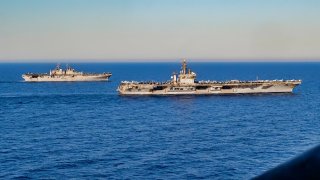Medium-Sized Aircraft Carriers Would Be a Mistake for the U.S. Navy
The U.S. Navy must rethink its approach to countering China's anti-access/area-denial (A2/AD) capabilities, threatening America's aircraft carriers. While medium-sized carriers, like those used by Japan, could be a cheaper and more replaceable alternative, the U.S. should instead focus on expanding its submarine fleet and developing unmanned undersea vehicles (UUVs).
Summary and Key Points: The U.S. Navy must rethink its approach to countering China's anti-access/area-denial (A2/AD) capabilities, threatening America's aircraft carriers. While medium-sized carriers, like those used by Japan, could be a cheaper and more replaceable alternative, the U.S. should instead focus on expanding its submarine fleet and developing unmanned undersea vehicles (UUVs).
-These assets are better suited for stealthy, effective operations in contested waters and would provide a more strategic advantage in a conflict with China.
America Needs More Subs and Unmanned Undersea Vehicles Not Medium-Sized Aircraft Carriers
The U.S. Navy will play a pivotal role in any conflict that might erupt between America and China. But China’s strong anti-access/area-denial (A2/AD) capability might keep the U.S. surface fleet out of the fight.
Currently, the U.S. possesses 11 aircraft carriers. They are the Navy’s primary power projection platforms. While the carriers can certainly defend themselves, China’s network of defenses won’t make the job easy – A2/AD systems are designed to damage or sink America’s mighty flattops.
The Navy needs to start planning how it will deal with this threat.
One suggestion is for the Navy to focus on deploying submarines in the event of a conflict with China. The problem then becomes that America’s submarine force is far too small. Its shipyards are having trouble keeping up with peacetime demand for any of the Navy’s warships, especially submarines.
Wartime demands are different, and the shipyards’ surge capacity is almost nonexistent. This threatens to leave the U.S. fleet with a very limited number of submarines at its disposal.
Medium-Sized Aircraft Carriers Needed?
Another idea is to build smaller aircraft carriers that are cheaper to construct and maintain. Losing such a vessel in combat would not be as catastrophic as the loss of one of America’s supercarriers.
Japan already has such a carrier.
The Japanese Maritime Self-Defense Force has a domestically built, advanced aircraft carrier they label a “helicopter carrier.” But it is a very capable aircraft carrier in its own right. It can carry the naval variant of the F-35 Lightning II fifth-generation warplane, which is built for Vertical Take Off and Landing to operate from carriers.
Japan thus has a significant capability that China is still slowly developing. It is less expensive than larger carriers and can be replaced if needed.
Of course, the Japanese carrier has more limited range than do American carriers. Since Japan is a regional power and is concerned only with regional threats, this isn’t much of a problem.
Do U.S. naval planners want to emulate this?
UUVs and Submarines Required
While it is preferable to the ghastly, easily targeted monstrosities the U.S. Navy operates today, the small carrier is still not preferable to submarines.
Medium-sized carriers of the kind that Japan operates are great, and they would be useful in any conflict with China. But the U.S. should encourage regional allies such as Japan, Australia, India, and South Korea to build these warships. The Americans, meanwhile, should throw every available resource into building more submarines and mass-producing unmanned undersea vehicles.
UUVs and submarines will be infinitely more useful than carriers for the Navy in a potential war with China. Too bad the American side cannot recognize this fact, become more innovative, and stop playing to the enemy’s expectations.
Author Experience and Expertise: Brandon J. Weichert
Brandon J. Weichert, a National Interest national security analyst, is a former Congressional staffer and geopolitical analyst who is a contributor at The Washington Times, the Asia Times, and The-Pipeline. He is the author of Winning Space: How America Remains a Superpower, Biohacked: China’s Race to Control Life, and The Shadow War: Iran’s Quest for Supremacy. His next book, A Disaster of Our Own Making: How the West Lost Ukraine, is due October 22 from Encounter Books. Weichert can be followed via Twitter @WeTheBrandon.
All images are Creative Commons or Shutterstock.
From the Vault
Russia Freaked Out: Why the U.S. Navy 'Unretired' the Iowa-Class Battleships
Battleship vs. Battlecruiser: Iowa-Class vs. Russia's Kirov-Class (Who Wins?)


